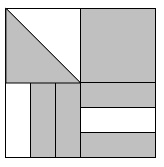Hints will display for most wrong answers; explanations for most right answers. You can attempt a question multiple times; it will only be scored correct if you get it right the first time.
I used the official objectives and sample test to construct these questions, but cannot promise that they accurately reflect what’s on the real test. Some of the sample questions were more convoluted than I could bear to write. See terms of use. See the MTEL Practice Test main page to view questions on a particular topic or to download paper practice tests.
MTEL General Curriculum Mathematics Practice
Question 1 |
A biology class requires a lab fee, which is a whole number of dollars, and the same amount for all students. On Monday the instructor collected $70 in fees, on Tuesday she collected $126, and on Wednesday she collected $266. What is the largest possible amount the fee could be?
$2Hint: A possible fee, but not the largest possible fee. Check the other choices to see which are factors of all three numbers. | |
$7Hint: A possible fee, but not the largest possible fee. Check the other choices to see which are factors of all three numbers. | |
$14Hint: This is the greatest common factor of 70, 126, and 266. | |
$70Hint: Not a factor of 126 or 266, so couldn't be correct. |
Question 2 |
The prime factorization of n can be written as n=pqr, where p, q, and r are distinct prime numbers. How many factors does n have, including 1 and itself?
\( \large3\) Hint: 1, p, q, r, and pqr are already 5, so this isn't enough. You might try plugging in p=2, q=3, and r=5 to help with this problem. | |
\( \large5\) Hint: Don't forget pq, etc. You might try plugging in p=2, q=3, and r=5 to help with this problem. | |
\( \large6\) Hint: You might try plugging in p=2, q=3, and r=5 to help with this problem. | |
\( \large8\) Hint: 1, p, q, r, pq, pr, qr, pqr. |
Question 3 |
In which table below is y a function of x?
 Hint: If x=3, y can have two different values, so it's not a function. | |
 Hint: If x=3, y can have two different values, so it's not a function. | |
 Hint: If x=1, y can have different values, so it's not a function. | |
 Hint: Each value of x always corresponds to the same value of y. |
Question 4 |
Which of the numbers below is a fraction equivalent to \( 0.\bar{6}\)?
\( \large \dfrac{4}{6}\) Hint: \( 0.\bar{6}=\dfrac{2}{3}=\dfrac{4}{6}\) | |
\( \large \dfrac{3}{5}\) Hint: This is equal to 0.6, without the repeating decimal. Answer is equivalent to choice c, which is another way to tell that it's wrong. | |
\( \large \dfrac{6}{10}\) Hint: This is equal to 0.6, without the repeating decimal. Answer is equivalent to choice b, which is another way to tell that it's wrong. | |
\( \large \dfrac{1}{6}\) Hint: This is less than a half, and \( 0.\bar{6}\) is greater than a half. |
Question 5 |
Which of the following is the equation of a linear function?
\( \large y={{x}^{2}}+2x+7\) Hint: This is a quadratic function. | |
\( \large y={{2}^{x}}\) Hint: This is an exponential function. | |
\( \large y=\dfrac{15}{x}\) Hint: This is an inverse function. | |
\( \large y=x+(x+4)\) Hint: This is a linear function, y=2x+4, it's graph is a straight line with slope 2 and y-intercept 4. |
Question 6 |
A class is using base-ten block to represent numbers. A large cube represents 1000, a flat represents 100, a rod represents 10, and a little cube represents 1. Which of these is not a correct representation for 2,347?
23 flats, 4 rods, 7 little cubesHint: Be sure you read the question carefully: 2300+40+7=2347 | |
2 large cubes, 3 flats, 47 rodsHint: 2000+300+470 \( \neq\) 2347 | |
2 large cubes, 34 rods, 7 little cubesHint: Be sure you read the question carefully: 2000+340+7=2347 | |
2 large cubes, 3 flats, 4 rods, 7 little cubesHint: Be sure you read the question carefully: 2000+300+40+7=2347 |
Question 7 |
Exactly one of the numbers below is a prime number. Which one is it?
\( \large511 \) Hint: Divisible by 7. | |
\( \large517\) Hint: Divisible by 11. | |
\( \large519\) Hint: Divisible by 3. | |
\( \large521\) |
Question 8 |
Which of the following inequalities describes all values of x with \(\large \dfrac{x}{2}\le \dfrac{x}{3}\)?
\( \large x < 0\) Hint: If x =0, then x/2 = x/3, so this answer can't be correct. | |
\( \large x \le 0\) | |
\( \large x > 0\) Hint: If x =0, then x/2 = x/3, so this answer can't be correct. | |
\( \large x \ge 0\) Hint: Try plugging in x = 6. |
Question 9 |
What is the mathematical name of the three-dimensional polyhedron depicted below?
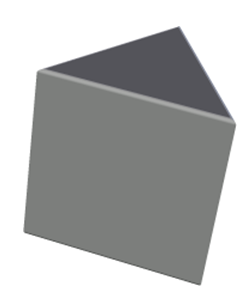
TetrahedronHint: All the faces of a tetrahedron are triangles. | |
Triangular PrismHint: A prism has two congruent, parallel bases, connected by parallelograms (since this is a right prism, the parallelograms are rectangles). | |
Triangular PyramidHint: A pyramid has one base, not two. | |
TrigonHint: A trigon is a triangle (this is not a common term). |
Question 10 |
A map has a scale of 3 inches = 100 miles. Cities A and B are 753 miles apart. Let d be the distance between the two cities on the map. Which of the following is not correct?
\( \large \dfrac{3}{100}=\dfrac{d}{753}\) Hint: Units on both side are inches/mile, and both numerators and denominators correspond -- this one is correct. | |
\( \large \dfrac{3}{100}=\dfrac{753}{d}\) Hint: Unit on the left is inches per mile, and on the right is miles per inch. The proportion is set up incorrectly (which is what we wanted). Another strategy is to notice that one of A or B has to be the answer because they cannot both be correct proportions. Then check that cross multiplying on A gives part D, so B is the one that is different from the other 3. | |
\( \large \dfrac{3}{d}=\dfrac{100}{753}\) Hint: Unitless on each side, as inches cancel on the left and miles on the right. Numerators correspond to the map, and denominators to the real life distances -- this one is correct. | |
\( \large 100d=3\cdot 753\) Hint: This is equivalent to part A. |
Question 11 |
Which of the following sets of polygons can be assembled to form a pentagonal pyramid?
2 pentagons and 5 rectangles.Hint: These can be assembled to form a pentagonal prism, not a pentagonal pyramid. | |
1 square and 5 equilateral triangles.Hint: You need a pentagon for a pentagonal pyramid. | |
1 pentagon and 5 isosceles triangles. | |
1 pentagon and 10 isosceles triangles. |
Question 12 |
Which of the numbers below is the decimal equivalent of \( \dfrac{3}{8}?\)
0.38Hint: If you are just writing the numerator next to the denominator then your technique is way off, but by coincidence your answer is close; try with 2/3 and 0.23 is nowhere near correct. | |
0.125Hint: This is 1/8, not 3/8. | |
0.375 | |
0.83Hint: 3/8 is less than a half, and 0.83 is more than a half, so they can't be equal. |
Question 13 |
\( \large \dfrac{17}{24}\) Hint: You might try adding segments so each quadrant is divided into 6 pieces with equal area -- there will be 24 regions, not all the same shape, but all the same area, with 17 of them shaded (for the top left quarter, you could also first change the diagonal line to a horizontal or vertical line that divides the square in two equal pieces and shade one) . | |
\( \large \dfrac{3}{4}\) Hint: Be sure you're taking into account the different sizes of the pieces. | |
\( \large \dfrac{2}{3}\) Hint: The bottom half of the picture is 2/3 shaded, and the top half is more than 2/3 shaded, so this answer is too small. | |
\( \large \dfrac{17}{6} \) Hint: This answer is bigger than 1, so doesn't make any sense. Be sure you are using the whole picture, not one quadrant, as the unit. |
Question 14 |
Here are some statements:
I) 5 is an integer II)\( -5 \) is an integer III) \(0\) is an integer
Which of the statements are true?
I only | |
I and II only | |
I and III only | |
I, II, and IIIHint: The integers are ...-3, -2, -1, 0, 1, 2, 3, .... |
Question 15 |
Use the solution procedure below to answer the question that follows:
\( \large {\left( x+3 \right)}^{2}=10\)
\( \large \left( x+3 \right)\left( x+3 \right)=10\)
\( \large {x}^{2}+9=10\)
\( \large {x}^{2}+9-9=10-9\)
\( \large {x}^{2}=1\)
\( \large x=1\text{ or }x=-1\)
Which of the following is incorrect in the procedure shown above?
The commutative property is used incorrectly.Hint: The commutative property is \(a+b=b+a\) or \(ab=ba\). | |
The associative property is used incorrectly.Hint: The associative property is \(a+(b+c)=(a+b)+c\) or
\(a \times (b \times c)=(a \times b) \times c\). | |
Order of operations is done incorrectly. | |
The distributive property is used incorrectly.Hint: \((x+3)(x+3)=x(x+3)+3(x+3)\)=\(x^2+3x+3x+9.\) |
Question 16 |
Elena is going to use a calculator to check whether or not 267 is prime. She will pick certain divisors, and then find 267 divided by each, and see if she gets a whole number. If she never gets a whole number, then she's found a prime. Which numbers does Elena NEED to check before she can stop checking and be sure she has a prime?
All natural numbers from 2 to 266.Hint: She only needs to check primes -- checking the prime factors of any composite is enough to look for divisors. As a test taking strategy, the other three choices involve primes, so worth thinking about. | |
All primes from 2 to 266 .Hint: Remember, factors come in pairs (except for square root factors), so she would first find the smaller of the pair and wouldn't need to check the larger. | |
All primes from 2 to 133 .Hint: She doesn't need to check this high. Factors come in pairs, and something over 100 is going to be paired with something less than 3, so she will find that earlier. | |
All primes from \( \large 2\) to \( \large \sqrt{267}\).Hint: \(\sqrt{267} \times \sqrt{267}=267\). Any other pair of factors will have one factor less than \( \sqrt{267}\) and one greater, so she only needs to check up to \( \sqrt{267}\). |
Question 17 |
The following story situations model \( 12\div 3\):
I) Jack has 12 cookies, which he wants to share equally between himself and two friends. How many cookies does each person get?
II) Trent has 12 cookies, which he wants to put into bags of 3 cookies each. How many bags can he make?
III) Cicely has $12. Cookies cost $3 each. How many cookies can she buy?
Which of these questions illustrate the same model of division, either partitive (partioning) or measurement (quotative)?
I and II | |
I and III | |
II and IIIHint: Problem I is partitive (or partitioning or sharing) -- we put 12 objects into 3 groups. Problems II and III are quotative (or measurement) -- we put 12 objects in groups of 3. | |
All three problems model the same meaning of division |
Question 18 |
The function d(x) gives the result when 12 is divided by x. Which of the following is a graph of d(x)?
 Hint: d(x) is 12 divided by x, not x divided by 12. | |
 Hint: When x=2, what should d(x) be? | |
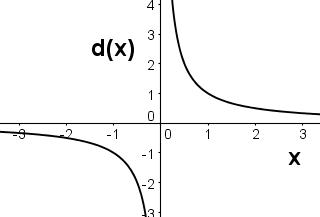 Hint: When x=2, what should d(x) be? | |
 |
Question 19 |
Which of the following is equal to eleven billion four hundred thousand?
\( \large 11,400,000\) Hint: That's eleven million four hundred thousand. | |
\(\large11,000,400,000\) | |
\( \large11,000,000,400,000\) Hint: That's eleven trillion four hundred thousand (although with British conventions; this answer is correct, but in the US, it isn't). | |
\( \large 11,400,000,000\) Hint: That's eleven billion four hundred million |
Question 20 |
A teacher has a list of all the countries in the world and their populations in March 2012. She is going to have her students use technology to compute the mean and median of the numbers on the list. Which of the following statements is true?
The teacher can be sure that the mean and median will be the same without doing any computation.Hint: Does this make sense? How likely is it that the mean and median of any large data set will be the same? | |
The teacher can be sure that the mean is bigger than the median without doing any computation.Hint: This is a skewed distribution, and very large countries like China and India contribute huge numbers to the mean, but are counted the same as small countries like Luxembourg in the median (the same thing happens w/data on salaries, where a few very high income people tilt the mean -- that's why such data is usually reported as medians). | |
The teacher can be sure that the median is bigger than the mean without doing any computation.Hint: Think about a set of numbers like 1, 2, 3, 4, 10,000 -- how do the mean/median compare? How might that relate to countries of the world? | |
There is no way for the teacher to know the relative size of the mean and median without computing them.Hint: Knowing the shape of the distribution of populations does give us enough info to know the relative size of the mean and median, even without computing them. |
Question 21 |
There are six gumballs in a bag — two red and four green. Six children take turns picking a gumball out of the bag without looking. They do not return any gumballs to the bag. What is the probability that the first two children to pick from the bag pick the red gumballs?
\( \large \dfrac{1}{3}\) Hint: This is the probability that the first child picks a red gumball, but not that the first two children pick red gumballs. | |
\( \large \dfrac{1}{8}\) Hint: Are you adding things that you should be multiplying? | |
\( \large \dfrac{1}{9}\) Hint: This would be the probability if the gumballs were returned to the bag. | |
\( \large \dfrac{1}{15}\) Hint: The probability that the first child picks red is 2/6 = 1/3. Then there are 5 gumballs in the bag, one red, so the probability that the second child picks red is 1/5. Thus 1/5 of the time, after the first child picks red, the second does too, so the probability is 1/5 x 1/3 = 1/15. |
Question 22 |
Which of the lists below is in order from least to greatest value?
\( \large \dfrac{1}{2},\quad \dfrac{1}{3},\quad \dfrac{1}{4},\quad \dfrac{1}{5}\) Hint: This is ordered from greatest to least. | |
\( \large \dfrac{1}{3},\quad \dfrac{2}{7},\quad \dfrac{3}{8},\quad \dfrac{4}{11}\) Hint: 1/3 = 2/6 is bigger than 2/7. | |
\( \large \dfrac{1}{4},\quad \dfrac{2}{5},\quad \dfrac{2}{3},\quad \dfrac{4}{5}\) Hint: One way to look at this: 1/4 and 2/5 are both less than 1/2, and 2/3 and 4/5 are both greater than 1/2. 1/4 is 25% and 2/5 is 40%, so 2/5 is greater. The distance from 2/3 to 1 is 1/3 and from 4/5 to 1 is 1/5, and 1/5 is less than 1/3, so 4/5 is bigger. | |
\( \large \dfrac{7}{8},\quad \dfrac{6}{7},\quad \dfrac{5}{6},\quad \dfrac{4}{5}\) Hint: This is in order from greatest to least. |
Question 23 |
Four children randomly line up, single file. What is the probability that they are in height order, with the shortest child in front? All of the children are different heights.
\( \large \dfrac{1}{4}\) Hint: Try a simpler question with 3 children -- call them big, medium, and small -- and list all the ways they could line up. Then see how to extend your logic to the problem with 4 children. | |
\( \large \dfrac{1}{256}
\) Hint: Try a simpler question with 3 children -- call them big, medium, and small -- and list all the ways they could line up. Then see how to extend your logic to the problem with 4 children. | |
\( \large \dfrac{1}{16}\) Hint: Try a simpler question with 3 children -- call them big, medium, and small -- and list all the ways they could line up. Then see how to extend your logic to the problem with 4 children. | |
\( \large \dfrac{1}{24}\) Hint: The number of ways for the children to line up is \(4!=4 \times 3 \times 2 \times 1 =24\) -- there are 4 choices for who is first in line, then 3 for who is second, etc. Only one of these lines has the children in the order specified. |
Question 24 |
Below is a pictorial representation of \(2\dfrac{1}{2}\div \dfrac{2}{3}\):
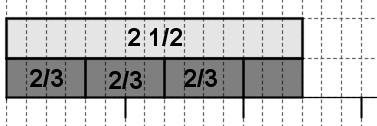
Which of the following is the best description of how to find the quotient from the picture?
The quotient is \(3\dfrac{3}{4}\). There are 3 whole blocks each representing \(\dfrac{2}{3}\) and a partial block composed of 3 small rectangles. The 3 small rectangles represent \(\dfrac{3}{4}\) of \(\dfrac{2}{3}\). | |
The quotient is \(3\dfrac{1}{2}\). There are 3 whole blocks each representing \(\dfrac{2}{3}\) and a partial block composed of 3 small rectangles. The 3 small rectangles represent \(\dfrac{3}{6}\) of a whole, or \(\dfrac{1}{2}\).Hint: We are counting how many 2/3's are in 2 1/2: the unit becomes 2/3, not 1. | |
The quotient is \(\dfrac{4}{15}\). There are four whole blocks separated into a total of 15 small rectangles.Hint: This explanation doesn't make much sense. Probably you are doing "invert and multiply," but inverting the wrong thing. | |
This picture cannot be used to find the quotient because it does not show how to separate \(2\dfrac{1}{2}\) into equal sized groups.Hint: Study the measurement/quotative model of division. It's often very useful with fractions. |
Question 25 |
The pattern below consists of a row of black squares surrounded by white squares.

How many white squares would surround a row of 157 black squares?
314Hint: Try your procedure on a smaller number that you can count to see where you made a mistake. | |
317Hint: Are there ever an odd number of white squares? | |
320Hint: One way to see this is that there are 6 tiles on the left and right ends, and the rest of the white tiles are twice the number of black tiles (there are many other ways to look at it too). | |
322Hint: Try your procedure on a smaller number that you can count to see where you made a mistake. |
Question 26 |
Below is a portion of a number line:

Point B is halfway between two tick marks. What number is represented by Point B?
\( \large 0.645\) Hint: That point is marked on the line, to the right. | |
\( \large 0.6421\) Hint: That point is to the left of point B. | |
\( \large 0.6422\) Hint: That point is to the left of point B. | |
\( \large 0.6425\) |
Question 27 |
Below are four inputs and outputs for a function machine representing the function A:
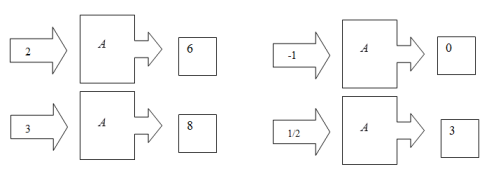
Which of the following equations could also represent A for the values shown?
\( \large A(n)=n+4\) Hint: For a question like this, you don't have to find the equation yourself, you can just try plugging the function machine inputs into the equation, and see if any values come out wrong. With this equation n= -1 would output 3, not 0 as the machine does. | |
\( \large A(n)=n+2\) Hint: For a question like this, you don't have to find the equation yourself, you can just try plugging the function machine inputs into the equation, and see if any values come out wrong. With this equation n= 2 would output 4, not 6 as the machine does. | |
\( \large A(n)=2n+2\) Hint: Simply plug in each of the four function machine input values, and see that the equation produces the correct output, e.g. A(2)=6, A(-1)=0, etc. | |
\( \large A(n)=2\left( n+2 \right)\) Hint: For a question like this, you don't have to find the equation yourself, you can just try plugging the function machine inputs into the equation, and see if any values come out wrong. With this equation n= 2 would output 8, not 6 as the machine does. |
Question 28 |
Use the expression below to answer the question that follows:
\( \large \dfrac{\left( 7,154 \right)\times \left( 896 \right)}{216}\)
Which of the following is the best estimate of the expression above?
2,000Hint: The answer is bigger than 7,000. | |
20,000Hint: Estimate 896/216 first. | |
3,000Hint: The answer is bigger than 7,000. | |
30,000Hint: \( \dfrac{896}{216} \approx 4\) and \(7154 \times 4\) is over 28,000, so this answer is closest. |
Question 29 |
Below are front, side, and top views of a three-dimensional solid.
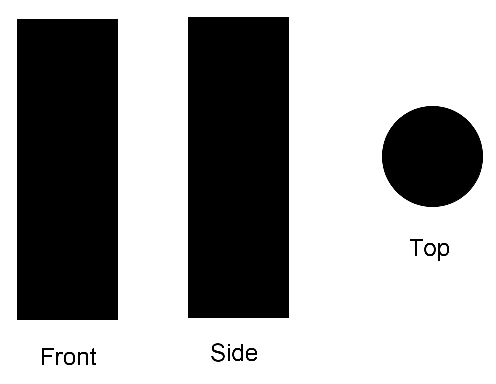
Which of the following could be the solid shown above?
A sphereHint: All views would be circles. | |
A cylinder | |
A coneHint: Two views would be triangles, not rectangles. | |
A pyramidHint: How would one view be a circle? |
Question 30 |
If x is an integer, which of the following must also be an integer?
\( \large \dfrac{x}{2}\) Hint: If x is odd, then \( \dfrac{x}{2} \) is not an integer, e.g. 3/2 = 1.5. | |
\( \large \dfrac{2}{x}\) Hint: Only an integer if x = -2, -1, 1, or 2. | |
\( \large-x\) Hint: -1 times any integer is still an integer. | |
\(\large\sqrt{x}\) Hint: Usually not an integer, e.g. \( \sqrt{2} \approx 1.414 \). |
Question 31 |
A family went on a long car trip. Below is a graph of how far they had driven at each hour.
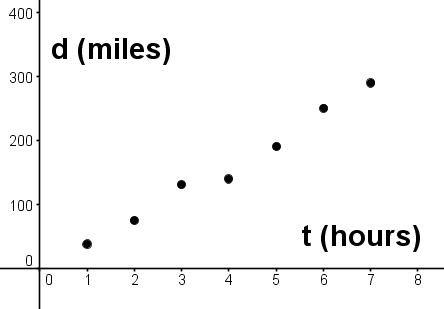
Which of the following is closest to their average speed driving on the trip?
\( \large d=20t\) Hint: Try plugging t=7 into the equation, and see how it matches the graph. | |
\( \large d=30t\) Hint: Try plugging t=7 into the equation, and see how it matches the graph. | |
\( \large d=40t\) | |
\( \large d=50t\) Hint: Try plugging t=7 into the equation, and see how it matches the graph. |
Question 32 |
Below is a portion of a number line.

Point A is one-quarter of the distance from 0.26 to 0.28. What number is represented by point A?
\( \large0.26\) Hint: Please reread the question. | |
\( \large0.2625\) Hint: This is one-quarter of the distance between 0.26 and 0.27, which is not what the question asked. | |
\( \large0.265\) | |
\( \large0.27\) Hint: Please read the question more carefully. This answer would be correct if Point A were halfway between the tick marks, but it's not. |
Question 33 |
What is the length of side \(\overline{BD}\) in the triangle below, where \(\angle DBA\) is a right angle?

\( \large 1\) Hint: Use the Pythagorean Theorem. | |
\( \large \sqrt{5}\) Hint: \(2^2+e^2=3^2\) or \(4+e^2=9;e^2=5; e=\sqrt{5}\). | |
\( \large \sqrt{13}\) Hint: e is not the hypotenuse. | |
\( \large 5\) Hint: Use the Pythagorean Theorem. |
Question 34 |
In each expression below N represents a negative integer. Which expression could have a negative value?
\( \large {{N}^{2}}\) Hint: Squaring always gives a non-negative value. | |
\( \large 6-N\) Hint: A story problem for this expression is, if it was 6 degrees out at noon and N degrees out at sunrise, by how many degrees did the temperature rise by noon? Since N is negative, the answer to this question has to be positive, and more than 6. | |
\( \large -N\) Hint: If N is negative, then -N is positive | |
\( \large 6+N\) Hint: For example, if \(N=-10\), then \(6+N = -4\) |
Question 35 |
The letters A, and B represent digits (possibly equal) in the ten digit number x=1,438,152,A3B. For which values of A and B is x divisible by 12, but not by 9?
\( \large A = 0, B = 4\) Hint: Digits add to 31, so not divisible by 3, so not divisible by 12. | |
\( \large A = 7, B = 2\) Hint: Digits add to 36, so divisible by 9. | |
\( \large A = 0, B = 6\) Hint: Digits add to 33, divisible by 3, not 9. Last digits are 36, so divisible by 4, and hence by 12. | |
\( \large A = 4, B = 8\) Hint: Digits add to 39, divisible by 3, not 9. Last digits are 38, so not divisible by 4, so not divisible by 12. |
Question 36 |
The chart below gives percentiles for the number of sit-ups that boys of various ages can do in 60 seconds (source , June 24, 2011)
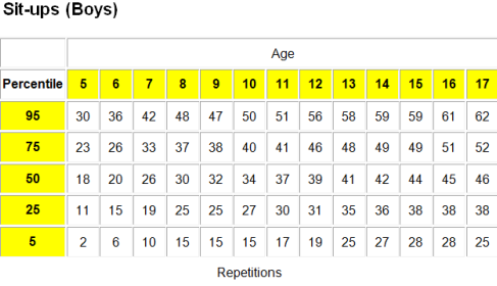
Which of the following statements can be inferred from the above chart?
95% of 12 year old boys can do 56 sit-ups in 60 seconds.Hint: The 95th percentile means that 95% of scores are less than or equal to 56, and 5% are greater than or equal to 56. | |
At most 25% of 7 year old boys can do 19 or more sit-ups in 60 seconds.Hint: The 25th percentile means that 25% of scores are less than or equal to 19, and 75% are greater than or equal to 19. | |
Half of all 13 year old boys can do less than 41 sit-ups in 60 seconds and half can do more than 41 sit-ups in 60 seconds.Hint: Close, but not quite. There's no accounting for boys who can do exactly 41 sit ups. Look at these data: 10, 20, 41, 41, 41, 41, 50, 60, 90. The median is 41, but more than half can do 41 or more. | |
At least 75% of 16 year old boys can only do 51 or fewer sit-ups in 60 seconds.Hint: The "at least" is necessary due to duplicates. Suppose the data were 10, 20, 51, 51. The 75th percentile is 51, but 100% of the boys can only do 51 or fewer situps. |
Question 37 |
Use the graph below to answer the question that follows:
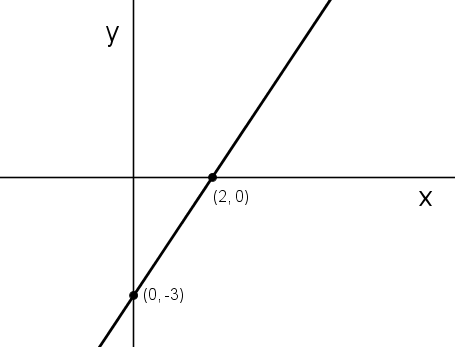
The graph above represents the equation \( \large 3x+Ay=B\), where A and B are integers. What are the values of A and B?
\( \large A = -2, B= 6\) Hint: Plug in (2,0) to get B=6, then plug in (0,-3) to get A=-2. | |
\( \large A = 2, B = 6\) Hint: Try plugging (0,-3) into this equation. | |
\( \large A = -1.5, B=-3\) Hint: The problem said that A and B were integers and -1.5 is not an integer. Don't try to use slope-intercept form. | |
\( \large A = 2, B = -3\) Hint: Try plugging (2,0) into this equation. |
Question 38 |
Kendra is trying to decide which fraction is greater, \( \dfrac{4}{7}\) or \( \dfrac{5}{8}\). Which of the following answers shows the best reasoning?
\( \dfrac{4}{7}\) is \( \dfrac{3}{7}\)away from 1, and \( \dfrac{5}{8}\) is \( \dfrac{3}{8}\)away from 1. Since eighth‘s are smaller than seventh‘s, \( \dfrac{5}{8}\) is closer to 1, and is the greater of the two fractions. | |
\( 7-4=3\) and \( 8-5=3\), so the fractions are equal.Hint: Not how to compare fractions. By this logic, 1/2 and 3/4 are equal, but 1/2 and 2/4 are not. | |
\( 4\times 8=32\) and \( 7\times 5=35\). Since \( 32<35\) , \( \dfrac{5}{8}<\dfrac{4}{7}\)Hint: Starts out as something that works, but the conclusion is wrong. 4/7 = 32/56 and 5/8 = 35/56. The cross multiplication gives the numerators, and 35/56 is bigger. | |
\( 4<5\) and \( 7<8\), so \( \dfrac{4}{7}<\dfrac{5}{8}\)Hint: Conclusion is correct, logic is wrong. With this reasoning, 1/2 would be less than 2/100,000. |
Question 39 |
Use the expression below to answer the question that follows.
\(\large \dfrac{\left( 155 \right)\times \left( 6,124 \right)}{977}\)
Which of the following is the best estimate of the expression above?
100Hint: 6124/977 is approximately 6. | |
200Hint: 6124/977 is approximately 6. | |
1,000Hint: 6124/977 is approximately 6. 155 is approximately 150, and \( 6 \times 150 = 3 \times 300 = 900\), so this answer is closest. | |
2,000Hint: 6124/977 is approximately 6. |
Question 40 |
The chairs in a large room can be arranged in rows of 18, 25, or 60 with no chairs left over. If C is the smallest possible number of chairs in the room, which of the following inequalities does C satisfy?
\( \large C\le 300\) Hint: Find the LCM. | |
\( \large 300 < C \le 500 \) Hint: Find the LCM. | |
\( \large 500 < C \le 700 \) Hint: Find the LCM. | |
\( \large C>700\) Hint: The LCM is 900, which is the smallest number of chairs. |
Question 41 |
Which of the following is closest to the height of a college student in centimeters?
1.6 cmHint: This is more the height of a Lego toy college student -- less than an inch! | |
16 cmHint: Less than knee high on most college students. | |
160 cmHint: Remember, a meter stick (a little bigger than a yard stick) is 100 cm. Also good to know is that 4 inches is approximately 10 cm. | |
1600 cmHint: This college student might be taller than some campus buildings! |
Question 42 |
The letters A, B, and C represent digits (possibly equal) in the twelve digit number x=111,111,111,ABC. For which values of A, B, and C is x divisible by 40?
\( \large A = 3, B = 2, C=0\) Hint: Note that it doesn't matter what the first 9 digits are, since 1000 is divisible by 40, so DEF,GHI,JKL,000 is divisible by 40 - we need to check the last 3. | |
\( \large A = 0, B = 0, C=4\) Hint: Not divisible by 10, since it doesn't end in 0. | |
\( \large A = 4, B = 2, C=0\) Hint: Divisible by 10 and by 4, but not by 40, as it's not divisible by 8. Look at 40 as the product of powers of primes -- 8 x 5, and check each. To check 8, either check whether 420 is divisible by 8, or take ones place + twice tens place + 4 * hundreds place = 18, which is not divisible by 8. | |
\( \large A =1, B=0, C=0\) Hint: Divisible by 10 and by 4, but not by 40, as it's not divisible by 8. Look at 40 as the product of powers of primes -- 8 x 5, and check each. To check 8, either check whether 100 is divisible by 8, or take ones place + twice tens place + 4 * hundreds place = 4, which is not divisible by 8. |
Question 43 |
Use the graph below to answer the question that follows:
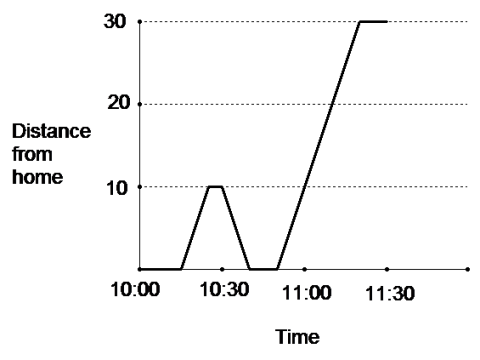
The graph above best matches which of the following scenarios:
George left home at 10:00 and drove to work on a crooked path. He was stopped in traffic at 10:30 and 10:45. He drove 30 miles total.Hint: Just because he ended up 30 miles from home doesn't mean he drove 30 miles total. | |
George drove to work. On the way to work there is a little hill and a big hill. He slowed down for them. He made it to work at 11:15.Hint: The graph is not a picture of the roads. | |
George left home at 10:15. He drove 10 miles, then realized he‘d forgotten something at home. He turned back and got what he‘d forgotten. Then he drove in a straight line, at many different speeds, until he got to work around 11:15.Hint: A straight line on a distance versus time graph means constant speed. | |
George left home at 10:15. He drove 10 miles, then realized he‘d forgotten something at home. He turned back and got what he‘d forgotten. Then he drove at a constant speed until he got to work around 11:15. |
Question 44 |
Which of the following is equal to one million three hundred thousand?
\(\large1.3\times {{10}^{6}}\)
| |
\(\large1.3\times {{10}^{9}}\)
Hint: That's one billion three hundred million. | |
\(\large1.03\times {{10}^{6}}\)
Hint: That's one million thirty thousand. | |
\(\large1.03\times {{10}^{9}}\) Hint: That's one billion thirty million |
Question 45 |
A homeowner is planning to tile the kitchen floor with tiles that measure 6 inches by 8 inches. The kitchen floor is a rectangle that measures 10 ft by 12 ft, and there are no gaps between the tiles. How many tiles does the homeowner need?
30Hint: The floor is 120 sq feet, and the tiles are smaller than 1 sq foot. Also, remember that 1 sq foot is 12 \(\times\) 12=144 sq inches. | |
120Hint: The floor is 120 sq feet, and the tiles are smaller than 1 sq foot. | |
300Hint: Recheck your calculations. | |
360Hint: One way to do this is to note that 6 inches = 1/2 foot and 8 inches = 2/3 foot, so the area of each tile is 1/2 \(\times\) 2/3=1/3 sq foot, or each square foot of floor requires 3 tiles. The area of the floor is 120 square feet. Note that the tiles would fit evenly oriented in either direction, parallel to the walls. |
|
List |
If you found a mistake or have comments on a particular question, please contact me (please copy and paste at least part of the question into the form, as the numbers change depending on how quizzes are displayed). General comments can be left here.
